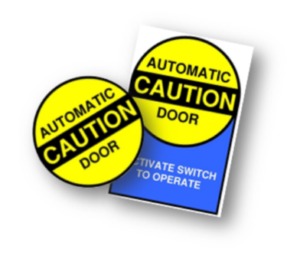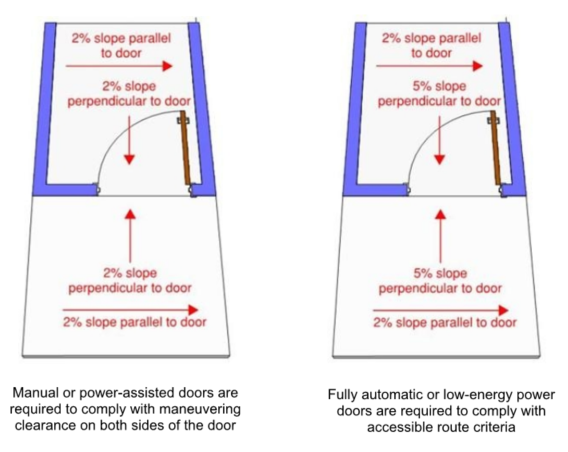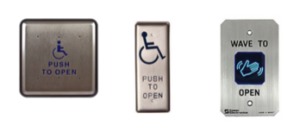- June 16, 2020
- 2 Comments
- In Accessible Design and Construction
- By Peter Stratton
 As the country continues to confront the realities of the COVID-19 pandemic, the way we navigate spaces is changing. One of these changes is the way we interact with common use objects that traditionally require hand-operation, like doors. While automatic doors have always been a good option for providing greater access to people with disabilities, hygiene concerns associated with the spread of disease have presented another argument for their use. The rise of touchless technology as a result of this pandemic will increase the use of automatic doors not just for accessibility or convenience, but for public health as well. For anyone considering incorporating automatic doors into their designs, either for new construction or as a retrofit, here are some important things to consider:
As the country continues to confront the realities of the COVID-19 pandemic, the way we navigate spaces is changing. One of these changes is the way we interact with common use objects that traditionally require hand-operation, like doors. While automatic doors have always been a good option for providing greater access to people with disabilities, hygiene concerns associated with the spread of disease have presented another argument for their use. The rise of touchless technology as a result of this pandemic will increase the use of automatic doors not just for accessibility or convenience, but for public health as well. For anyone considering incorporating automatic doors into their designs, either for new construction or as a retrofit, here are some important things to consider:
Types of Automatic Doors
There are three types of automatic doors: power-assisted, fully automatic, and low-energy operated.
- Power-assisted doors require a user to begin to open the door before the automatic opener engages.
- Fully automatic doors open upon approach. This type of door can typically be found at entrances to grocery and retail stores.
- Low-energy power doors require an action such as pushing a button or waving a hand over a sensor to activate the door opening. This type of door is typically used when access control is required. These doors are also useful for retrofitting existing doors where maneuvering clearances are required but not provided.
The type of automatic door used will trigger different accessibility requirements.
- Where fully automatic and low-energy doors are provided, accessible maneuvering clearance is not required as long as the doors have standby power or remain open in the power-off condition. Power-assisted doors, however, still require compliant maneuvering clearance.
- The slope of the floor or ground surface at automatic doors is also measured differently than it is for manual doors. At manual or power-assisted doors, a level landing with a 2% slope in all directions is required. Conversely, because fully automatic and low-energy power doors are exempt from maneuvering clearance, a level landing with a 2% slope in all directions is not required. However, the ground or floor surface at automatic doors is still subject to accessible route criteria, which includes a maximum 2% cross slope and a maximum 5% running slope on both sides of the door. And, a level clear floor space is still required at the controls that activate low-energy doors.
-
The minimum clear width for automatic door systems is measured differently than it is for manual doors. While at least one leaf of a manual double leaf door must provide a 32 inch minimum clear opening width, the clear opening width of an automatic door is measured when both leaves are in the open position. However, the clear opening must be provided in both the power-on and power-off modes.

The minimum clear width of automatic door systems is measured with all leaves in the open position. The 32″ minimum required clear opening must be provided in both power-on and power-off modes.
Automatic Door Components
The parts needed to make an automatic door work depend on the use. Fully automatic doors may only need an automatic operator, while more complex door systems may require additional parts.
The operator is the main part of the door opening system that houses the motor and has either an articulating arm or sliding mechanism. The operators can either be electromechanical or electrohydraulic. Electromechanical operators are used on doors where the automatic opening function is the primary use. Electrohydraulic operators are used on doors that are primarily intended for manual operation but can also be operated via wall switches or motion sensors. These operators incorporate a standard door closer with the automatic operation.
Low-energy doors require an actuator to engage the operator. The actuators can be hardwired or wireless. In addition to push buttons, the actuators can be hands-free or “wave-to-open”. Where a latch is provided, a method to unlatch the door when the actuator is depressed is required. Either the strike or the latch can be electrified to release when the automatic door is activated. In addition, a power supply box is required, which houses the AC/DC power converter for the latch, the backup battery for the whole system, and the relay board that ties the operator, actuator, and latch release together. Ventilation is required for the power supply box, so its installation location is important to consider.
As COVID-19 changes the way we design, we must be mindful of the way these changes affect accessibility and impact the way we navigate the built environment. Solutions like automatic doors, when installed with proper planning, have the potential to positively impact public health and safety while also providing greater access to a person with a disability.
We’re here to help! Contact us to learn more about our accessibility consulting services.
Written by David Mike, Accessibility Specialist





I didn’t know that automatic doors could either have an articulating or sliding mechanism. I think having automatic doors for pedestrians would be a good idea for most buildings. That way, people with disabilities or with their hands full could still easily get in.
Thanks for the info about automated doors. My brother is interested in getting an automated door. I’ll share this article with him as he looks for an automated door.